Effective Workplace Communication: Importance, Methods & Records
VerifiedAdded on 2023/06/13
|17
|5279
|205
Essay
AI Summary
This essay explores the critical role of clear and effective communication in the workplace, highlighting its impact on organizational operations, employee morale, and innovation. It examines various communication models, including vertical, horizontal, and external communication, emphasizing the importance of verbal, non-verbal, and written communication skills. The essay outlines the key stages in the communication process, from sender to receiver, and identifies potential barriers such as physical, language, psychological, emotional, and perceptual obstacles. Furthermore, it discusses methods to enhance communication, such as teamwork, training, online tools, and open-door policies. Finally, the essay underscores the importance of maintaining accurate communication records for informed decision-making, financial monitoring, and legal compliance, making it a comprehensive guide to effective workplace communication strategies. This student-contributed essay is available on Desklib, a platform providing study tools for students.
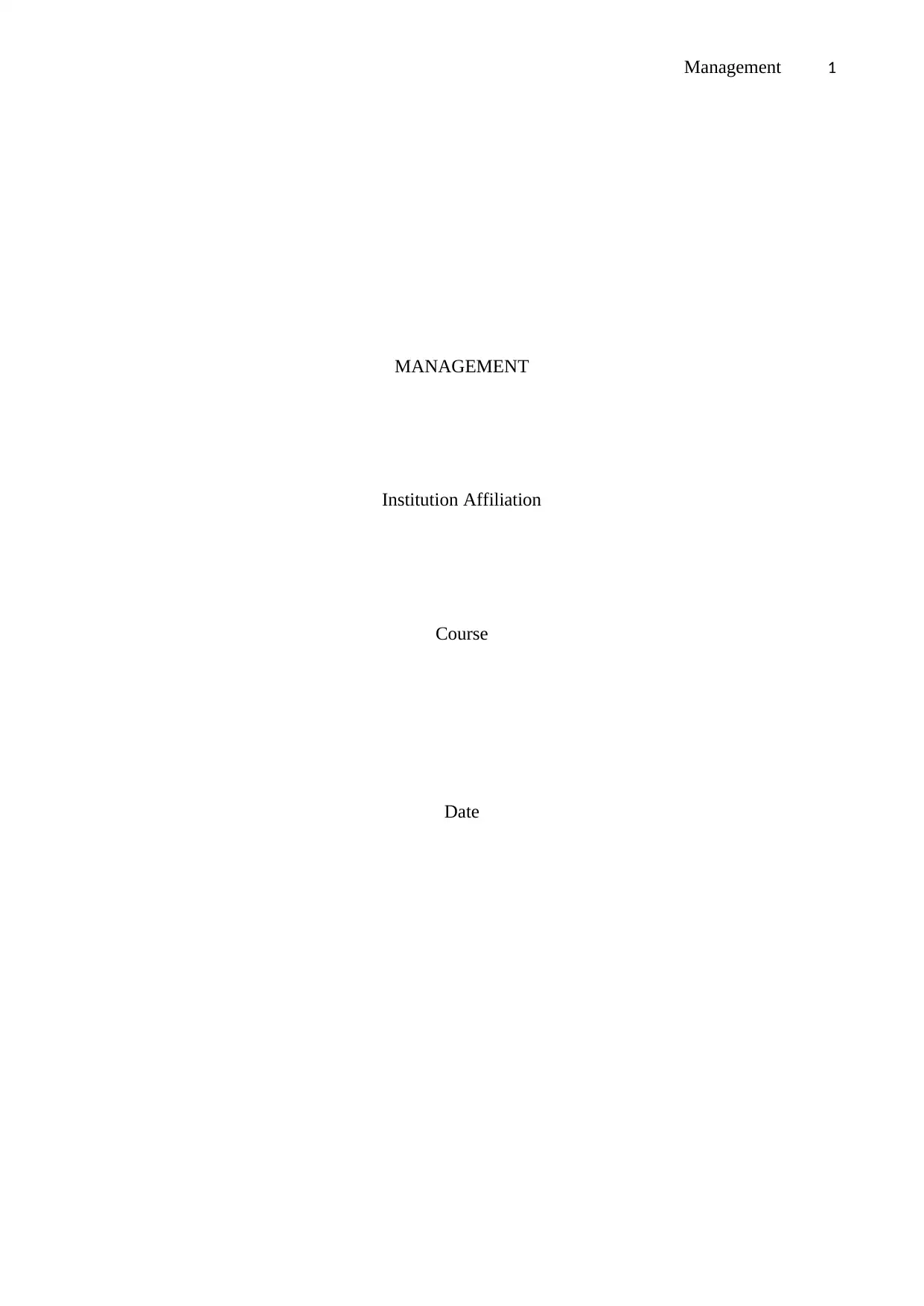
Management 1
MANAGEMENT
Institution Affiliation
Course
Date
MANAGEMENT
Institution Affiliation
Course
Date
Paraphrase This Document
Need a fresh take? Get an instant paraphrase of this document with our AI Paraphraser
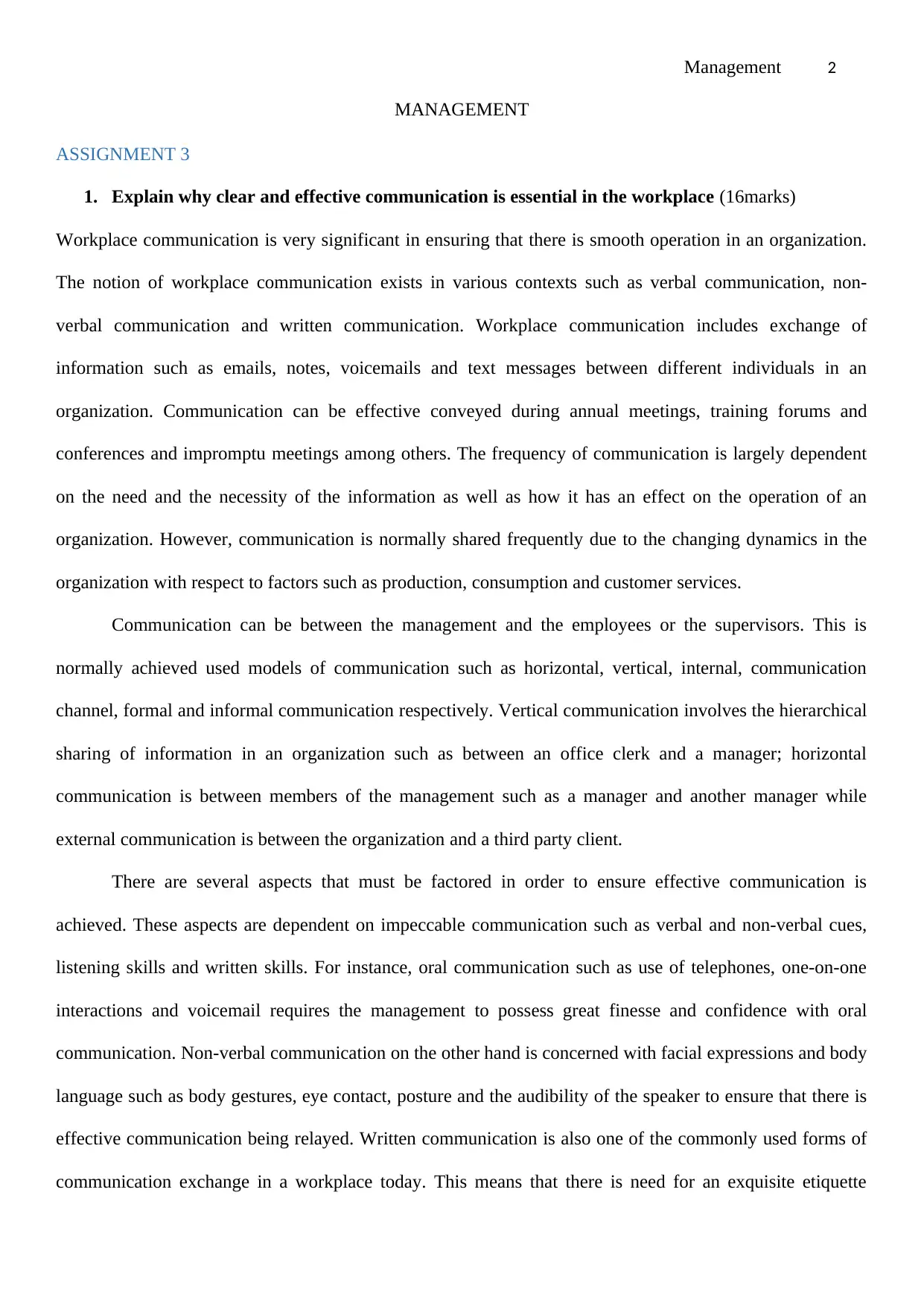
Management 2
MANAGEMENT
ASSIGNMENT 3
1. Explain why clear and effective communication is essential in the workplace (16marks)
Workplace communication is very significant in ensuring that there is smooth operation in an organization.
The notion of workplace communication exists in various contexts such as verbal communication, non-
verbal communication and written communication. Workplace communication includes exchange of
information such as emails, notes, voicemails and text messages between different individuals in an
organization. Communication can be effective conveyed during annual meetings, training forums and
conferences and impromptu meetings among others. The frequency of communication is largely dependent
on the need and the necessity of the information as well as how it has an effect on the operation of an
organization. However, communication is normally shared frequently due to the changing dynamics in the
organization with respect to factors such as production, consumption and customer services.
Communication can be between the management and the employees or the supervisors. This is
normally achieved used models of communication such as horizontal, vertical, internal, communication
channel, formal and informal communication respectively. Vertical communication involves the hierarchical
sharing of information in an organization such as between an office clerk and a manager; horizontal
communication is between members of the management such as a manager and another manager while
external communication is between the organization and a third party client.
There are several aspects that must be factored in order to ensure effective communication is
achieved. These aspects are dependent on impeccable communication such as verbal and non-verbal cues,
listening skills and written skills. For instance, oral communication such as use of telephones, one-on-one
interactions and voicemail requires the management to possess great finesse and confidence with oral
communication. Non-verbal communication on the other hand is concerned with facial expressions and body
language such as body gestures, eye contact, posture and the audibility of the speaker to ensure that there is
effective communication being relayed. Written communication is also one of the commonly used forms of
communication exchange in a workplace today. This means that there is need for an exquisite etiquette
MANAGEMENT
ASSIGNMENT 3
1. Explain why clear and effective communication is essential in the workplace (16marks)
Workplace communication is very significant in ensuring that there is smooth operation in an organization.
The notion of workplace communication exists in various contexts such as verbal communication, non-
verbal communication and written communication. Workplace communication includes exchange of
information such as emails, notes, voicemails and text messages between different individuals in an
organization. Communication can be effective conveyed during annual meetings, training forums and
conferences and impromptu meetings among others. The frequency of communication is largely dependent
on the need and the necessity of the information as well as how it has an effect on the operation of an
organization. However, communication is normally shared frequently due to the changing dynamics in the
organization with respect to factors such as production, consumption and customer services.
Communication can be between the management and the employees or the supervisors. This is
normally achieved used models of communication such as horizontal, vertical, internal, communication
channel, formal and informal communication respectively. Vertical communication involves the hierarchical
sharing of information in an organization such as between an office clerk and a manager; horizontal
communication is between members of the management such as a manager and another manager while
external communication is between the organization and a third party client.
There are several aspects that must be factored in order to ensure effective communication is
achieved. These aspects are dependent on impeccable communication such as verbal and non-verbal cues,
listening skills and written skills. For instance, oral communication such as use of telephones, one-on-one
interactions and voicemail requires the management to possess great finesse and confidence with oral
communication. Non-verbal communication on the other hand is concerned with facial expressions and body
language such as body gestures, eye contact, posture and the audibility of the speaker to ensure that there is
effective communication being relayed. Written communication is also one of the commonly used forms of
communication exchange in a workplace today. This means that there is need for an exquisite etiquette
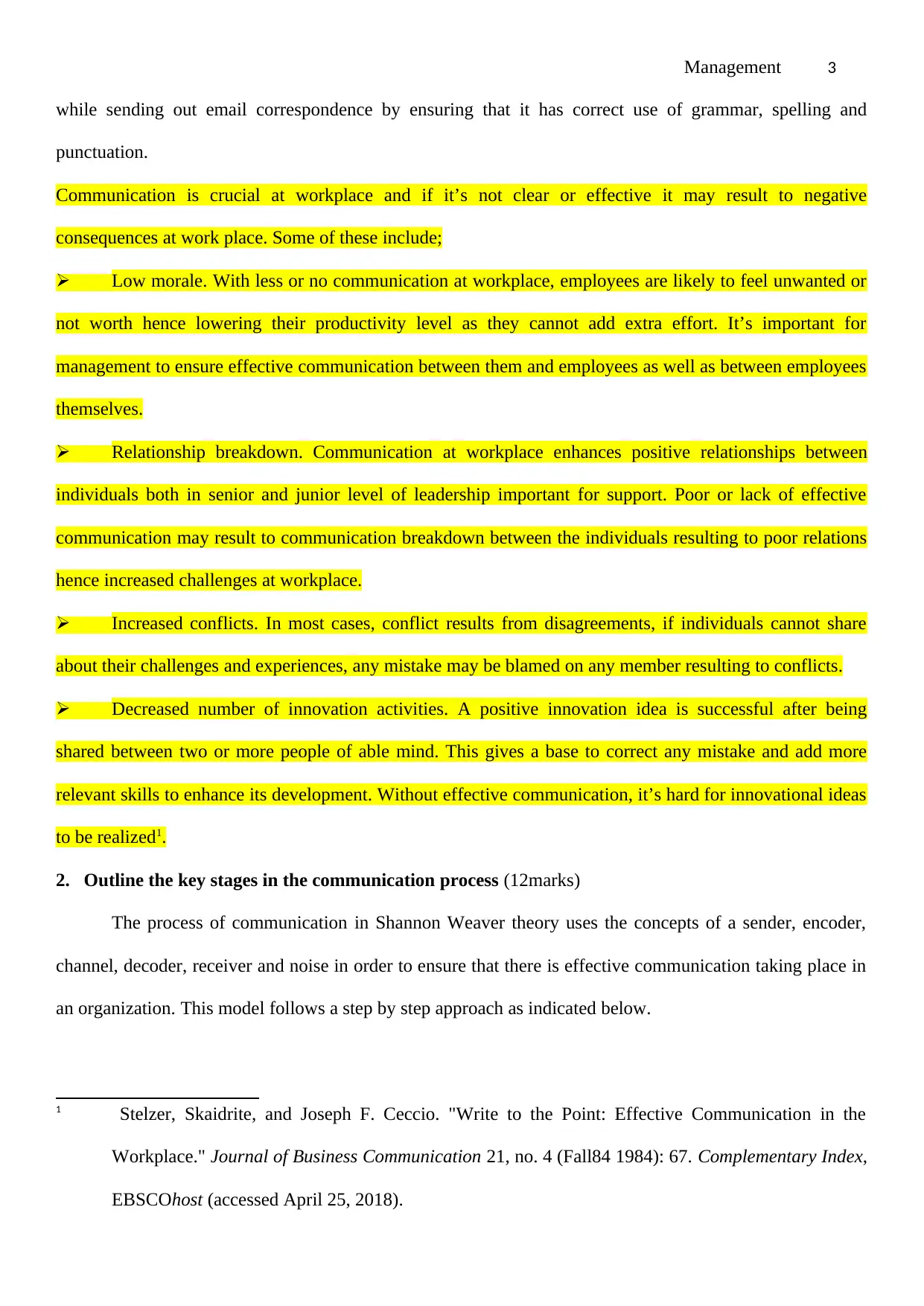
Management 3
while sending out email correspondence by ensuring that it has correct use of grammar, spelling and
punctuation.
Communication is crucial at workplace and if it’s not clear or effective it may result to negative
consequences at work place. Some of these include;
Low morale. With less or no communication at workplace, employees are likely to feel unwanted or
not worth hence lowering their productivity level as they cannot add extra effort. It’s important for
management to ensure effective communication between them and employees as well as between employees
themselves.
Relationship breakdown. Communication at workplace enhances positive relationships between
individuals both in senior and junior level of leadership important for support. Poor or lack of effective
communication may result to communication breakdown between the individuals resulting to poor relations
hence increased challenges at workplace.
Increased conflicts. In most cases, conflict results from disagreements, if individuals cannot share
about their challenges and experiences, any mistake may be blamed on any member resulting to conflicts.
Decreased number of innovation activities. A positive innovation idea is successful after being
shared between two or more people of able mind. This gives a base to correct any mistake and add more
relevant skills to enhance its development. Without effective communication, it’s hard for innovational ideas
to be realized1.
2. Outline the key stages in the communication process (12marks)
The process of communication in Shannon Weaver theory uses the concepts of a sender, encoder,
channel, decoder, receiver and noise in order to ensure that there is effective communication taking place in
an organization. This model follows a step by step approach as indicated below.
1 Stelzer, Skaidrite, and Joseph F. Ceccio. "Write to the Point: Effective Communication in the
Workplace." Journal of Business Communication 21, no. 4 (Fall84 1984): 67. Complementary Index,
EBSCOhost (accessed April 25, 2018).
while sending out email correspondence by ensuring that it has correct use of grammar, spelling and
punctuation.
Communication is crucial at workplace and if it’s not clear or effective it may result to negative
consequences at work place. Some of these include;
Low morale. With less or no communication at workplace, employees are likely to feel unwanted or
not worth hence lowering their productivity level as they cannot add extra effort. It’s important for
management to ensure effective communication between them and employees as well as between employees
themselves.
Relationship breakdown. Communication at workplace enhances positive relationships between
individuals both in senior and junior level of leadership important for support. Poor or lack of effective
communication may result to communication breakdown between the individuals resulting to poor relations
hence increased challenges at workplace.
Increased conflicts. In most cases, conflict results from disagreements, if individuals cannot share
about their challenges and experiences, any mistake may be blamed on any member resulting to conflicts.
Decreased number of innovation activities. A positive innovation idea is successful after being
shared between two or more people of able mind. This gives a base to correct any mistake and add more
relevant skills to enhance its development. Without effective communication, it’s hard for innovational ideas
to be realized1.
2. Outline the key stages in the communication process (12marks)
The process of communication in Shannon Weaver theory uses the concepts of a sender, encoder,
channel, decoder, receiver and noise in order to ensure that there is effective communication taking place in
an organization. This model follows a step by step approach as indicated below.
1 Stelzer, Skaidrite, and Joseph F. Ceccio. "Write to the Point: Effective Communication in the
Workplace." Journal of Business Communication 21, no. 4 (Fall84 1984): 67. Complementary Index,
EBSCOhost (accessed April 25, 2018).
⊘ This is a preview!⊘
Do you want full access?
Subscribe today to unlock all pages.

Trusted by 1+ million students worldwide
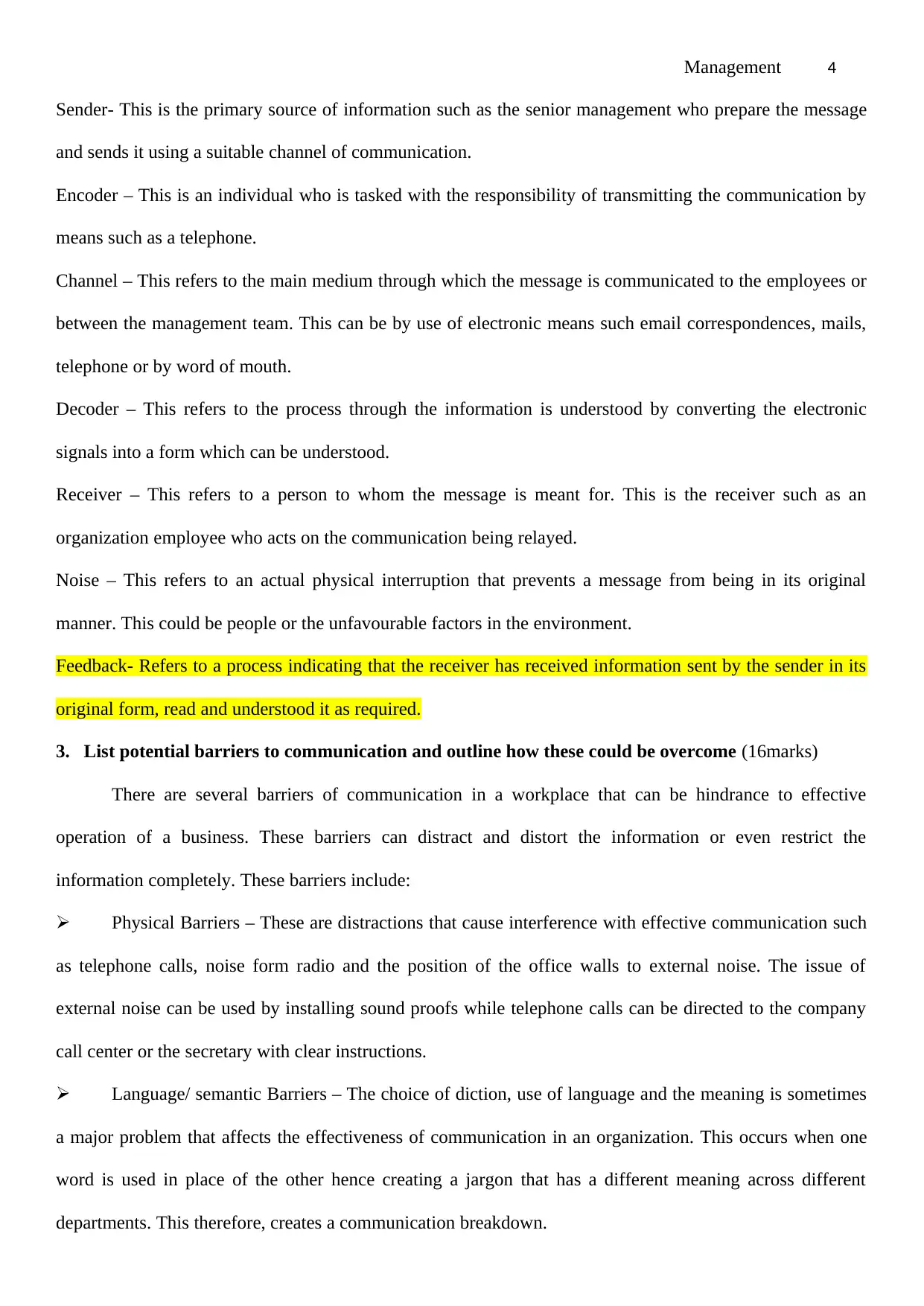
Management 4
Sender- This is the primary source of information such as the senior management who prepare the message
and sends it using a suitable channel of communication.
Encoder – This is an individual who is tasked with the responsibility of transmitting the communication by
means such as a telephone.
Channel – This refers to the main medium through which the message is communicated to the employees or
between the management team. This can be by use of electronic means such email correspondences, mails,
telephone or by word of mouth.
Decoder – This refers to the process through the information is understood by converting the electronic
signals into a form which can be understood.
Receiver – This refers to a person to whom the message is meant for. This is the receiver such as an
organization employee who acts on the communication being relayed.
Noise – This refers to an actual physical interruption that prevents a message from being in its original
manner. This could be people or the unfavourable factors in the environment.
Feedback- Refers to a process indicating that the receiver has received information sent by the sender in its
original form, read and understood it as required.
3. List potential barriers to communication and outline how these could be overcome (16marks)
There are several barriers of communication in a workplace that can be hindrance to effective
operation of a business. These barriers can distract and distort the information or even restrict the
information completely. These barriers include:
Physical Barriers – These are distractions that cause interference with effective communication such
as telephone calls, noise form radio and the position of the office walls to external noise. The issue of
external noise can be used by installing sound proofs while telephone calls can be directed to the company
call center or the secretary with clear instructions.
Language/ semantic Barriers – The choice of diction, use of language and the meaning is sometimes
a major problem that affects the effectiveness of communication in an organization. This occurs when one
word is used in place of the other hence creating a jargon that has a different meaning across different
departments. This therefore, creates a communication breakdown.
Sender- This is the primary source of information such as the senior management who prepare the message
and sends it using a suitable channel of communication.
Encoder – This is an individual who is tasked with the responsibility of transmitting the communication by
means such as a telephone.
Channel – This refers to the main medium through which the message is communicated to the employees or
between the management team. This can be by use of electronic means such email correspondences, mails,
telephone or by word of mouth.
Decoder – This refers to the process through the information is understood by converting the electronic
signals into a form which can be understood.
Receiver – This refers to a person to whom the message is meant for. This is the receiver such as an
organization employee who acts on the communication being relayed.
Noise – This refers to an actual physical interruption that prevents a message from being in its original
manner. This could be people or the unfavourable factors in the environment.
Feedback- Refers to a process indicating that the receiver has received information sent by the sender in its
original form, read and understood it as required.
3. List potential barriers to communication and outline how these could be overcome (16marks)
There are several barriers of communication in a workplace that can be hindrance to effective
operation of a business. These barriers can distract and distort the information or even restrict the
information completely. These barriers include:
Physical Barriers – These are distractions that cause interference with effective communication such
as telephone calls, noise form radio and the position of the office walls to external noise. The issue of
external noise can be used by installing sound proofs while telephone calls can be directed to the company
call center or the secretary with clear instructions.
Language/ semantic Barriers – The choice of diction, use of language and the meaning is sometimes
a major problem that affects the effectiveness of communication in an organization. This occurs when one
word is used in place of the other hence creating a jargon that has a different meaning across different
departments. This therefore, creates a communication breakdown.
Paraphrase This Document
Need a fresh take? Get an instant paraphrase of this document with our AI Paraphraser

Management 5
Psychological Barriers – These are the social barriers that create a difference in status and mood of
an individual as well as the psychological distance. The needs, expectations, values and experiences of
employees may overlap hence creating a communication barrier due to filtering of the information. These
failures are commonly attributed to factors such as sincerity and straightforwardness, empathy, role
perception and role perception.
Emotional Barriers – these include worries such the fear of losing a job that may occupy the minds of
the employees hence affecting commutation. Poor working conditions and lack of performance appraisal
may also contribute to communication breakdown.
Perceptual Barriers – This breaks down the communication because different employees may have
different perceptions on how to approach a particular problem hence affective the collective team spirit of
the organization.
UNDERSTAND METHODS OF COMMUNCIATION
4. Explain methods of communication and their best use when communicating with the team (16
marks)
An organization can use several proven methods to boost the overall communication across all the
departments and other components in an organization. These strategies are very beneficial in increase the
overall team work among all the members, hence creative an efficient sharing of information. These
strategies include and not limited to the following:
Team work- The organization should ensure that all the employees and the management share
common interest and that they are all given equal opportunities to contribute to the success of the
organization. This enables them to interact mutually and boost their productivity because their working
environment is conducive to carry out their duties.
Trainings and Workshops – This provides an opportunity for employees to sharpen their skills and
learn new ways of improving their productivity. They are able to work together as team towards a common
Psychological Barriers – These are the social barriers that create a difference in status and mood of
an individual as well as the psychological distance. The needs, expectations, values and experiences of
employees may overlap hence creating a communication barrier due to filtering of the information. These
failures are commonly attributed to factors such as sincerity and straightforwardness, empathy, role
perception and role perception.
Emotional Barriers – these include worries such the fear of losing a job that may occupy the minds of
the employees hence affecting commutation. Poor working conditions and lack of performance appraisal
may also contribute to communication breakdown.
Perceptual Barriers – This breaks down the communication because different employees may have
different perceptions on how to approach a particular problem hence affective the collective team spirit of
the organization.
UNDERSTAND METHODS OF COMMUNCIATION
4. Explain methods of communication and their best use when communicating with the team (16
marks)
An organization can use several proven methods to boost the overall communication across all the
departments and other components in an organization. These strategies are very beneficial in increase the
overall team work among all the members, hence creative an efficient sharing of information. These
strategies include and not limited to the following:
Team work- The organization should ensure that all the employees and the management share
common interest and that they are all given equal opportunities to contribute to the success of the
organization. This enables them to interact mutually and boost their productivity because their working
environment is conducive to carry out their duties.
Trainings and Workshops – This provides an opportunity for employees to sharpen their skills and
learn new ways of improving their productivity. They are able to work together as team towards a common
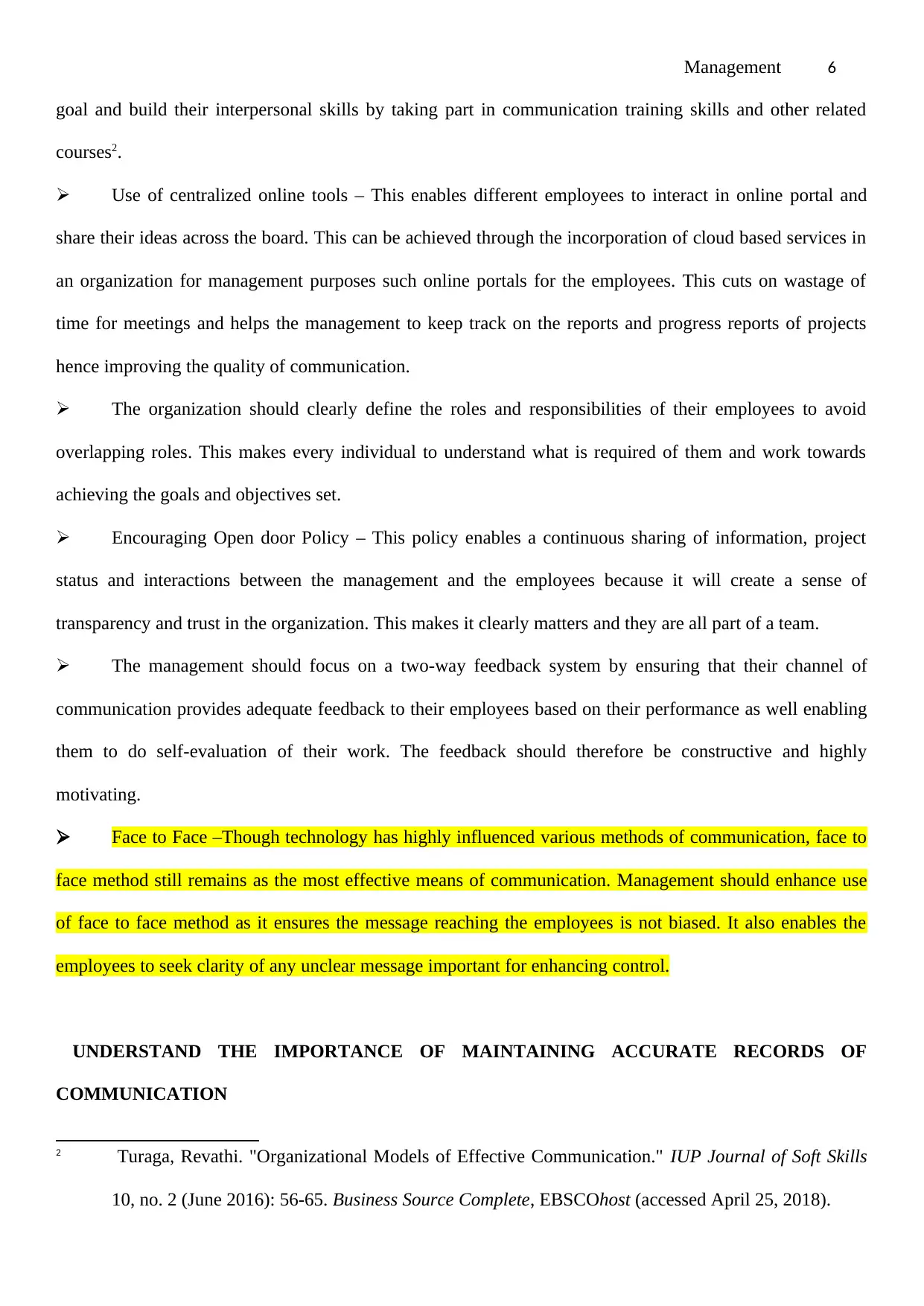
Management 6
goal and build their interpersonal skills by taking part in communication training skills and other related
courses2.
Use of centralized online tools – This enables different employees to interact in online portal and
share their ideas across the board. This can be achieved through the incorporation of cloud based services in
an organization for management purposes such online portals for the employees. This cuts on wastage of
time for meetings and helps the management to keep track on the reports and progress reports of projects
hence improving the quality of communication.
The organization should clearly define the roles and responsibilities of their employees to avoid
overlapping roles. This makes every individual to understand what is required of them and work towards
achieving the goals and objectives set.
Encouraging Open door Policy – This policy enables a continuous sharing of information, project
status and interactions between the management and the employees because it will create a sense of
transparency and trust in the organization. This makes it clearly matters and they are all part of a team.
The management should focus on a two-way feedback system by ensuring that their channel of
communication provides adequate feedback to their employees based on their performance as well enabling
them to do self-evaluation of their work. The feedback should therefore be constructive and highly
motivating.
Face to Face –Though technology has highly influenced various methods of communication, face to
face method still remains as the most effective means of communication. Management should enhance use
of face to face method as it ensures the message reaching the employees is not biased. It also enables the
employees to seek clarity of any unclear message important for enhancing control.
UNDERSTAND THE IMPORTANCE OF MAINTAINING ACCURATE RECORDS OF
COMMUNICATION
2 Turaga, Revathi. "Organizational Models of Effective Communication." IUP Journal of Soft Skills
10, no. 2 (June 2016): 56-65. Business Source Complete, EBSCOhost (accessed April 25, 2018).
goal and build their interpersonal skills by taking part in communication training skills and other related
courses2.
Use of centralized online tools – This enables different employees to interact in online portal and
share their ideas across the board. This can be achieved through the incorporation of cloud based services in
an organization for management purposes such online portals for the employees. This cuts on wastage of
time for meetings and helps the management to keep track on the reports and progress reports of projects
hence improving the quality of communication.
The organization should clearly define the roles and responsibilities of their employees to avoid
overlapping roles. This makes every individual to understand what is required of them and work towards
achieving the goals and objectives set.
Encouraging Open door Policy – This policy enables a continuous sharing of information, project
status and interactions between the management and the employees because it will create a sense of
transparency and trust in the organization. This makes it clearly matters and they are all part of a team.
The management should focus on a two-way feedback system by ensuring that their channel of
communication provides adequate feedback to their employees based on their performance as well enabling
them to do self-evaluation of their work. The feedback should therefore be constructive and highly
motivating.
Face to Face –Though technology has highly influenced various methods of communication, face to
face method still remains as the most effective means of communication. Management should enhance use
of face to face method as it ensures the message reaching the employees is not biased. It also enables the
employees to seek clarity of any unclear message important for enhancing control.
UNDERSTAND THE IMPORTANCE OF MAINTAINING ACCURATE RECORDS OF
COMMUNICATION
2 Turaga, Revathi. "Organizational Models of Effective Communication." IUP Journal of Soft Skills
10, no. 2 (June 2016): 56-65. Business Source Complete, EBSCOhost (accessed April 25, 2018).
⊘ This is a preview!⊘
Do you want full access?
Subscribe today to unlock all pages.

Trusted by 1+ million students worldwide
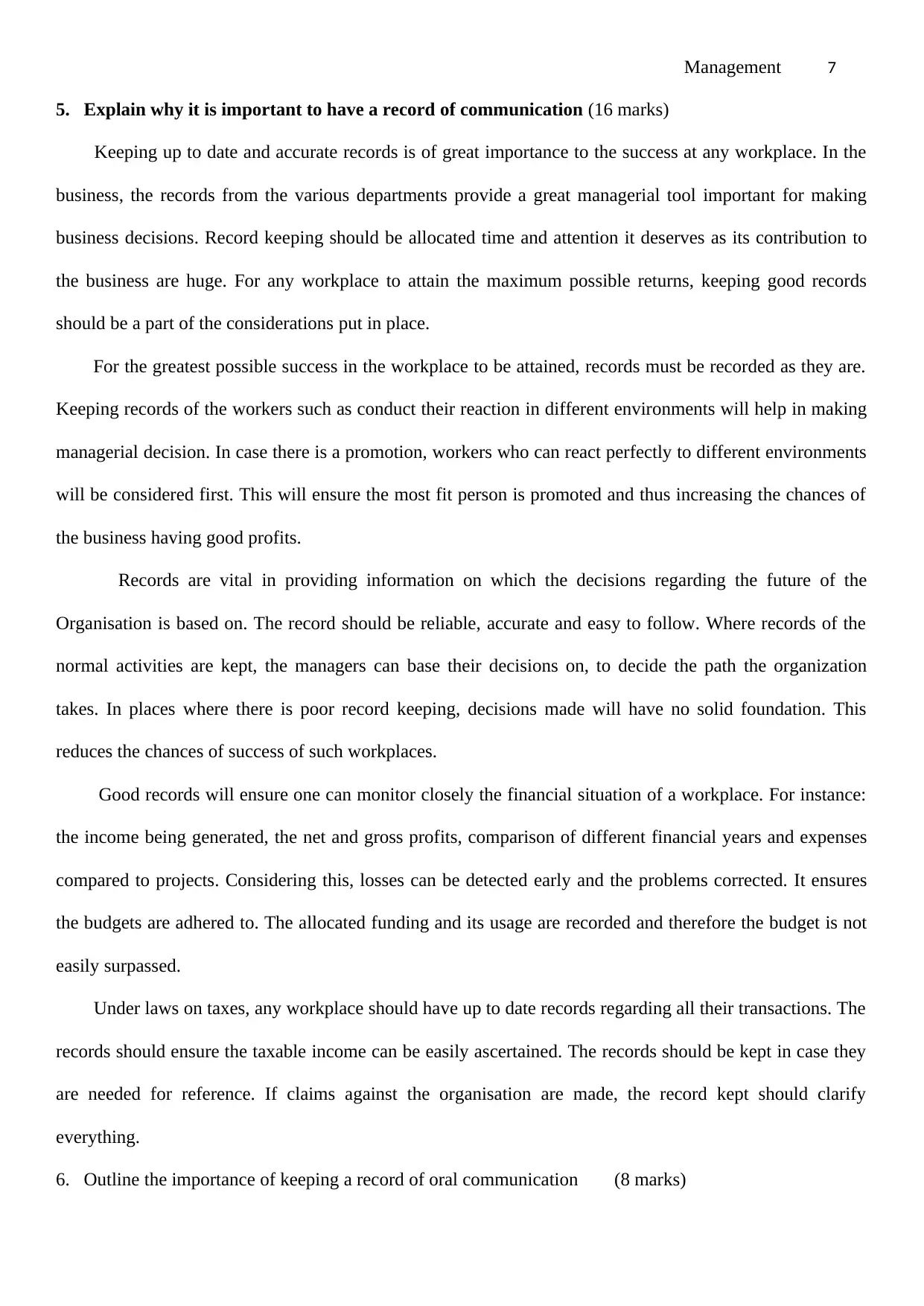
Management 7
5. Explain why it is important to have a record of communication (16 marks)
Keeping up to date and accurate records is of great importance to the success at any workplace. In the
business, the records from the various departments provide a great managerial tool important for making
business decisions. Record keeping should be allocated time and attention it deserves as its contribution to
the business are huge. For any workplace to attain the maximum possible returns, keeping good records
should be a part of the considerations put in place.
For the greatest possible success in the workplace to be attained, records must be recorded as they are.
Keeping records of the workers such as conduct their reaction in different environments will help in making
managerial decision. In case there is a promotion, workers who can react perfectly to different environments
will be considered first. This will ensure the most fit person is promoted and thus increasing the chances of
the business having good profits.
Records are vital in providing information on which the decisions regarding the future of the
Organisation is based on. The record should be reliable, accurate and easy to follow. Where records of the
normal activities are kept, the managers can base their decisions on, to decide the path the organization
takes. In places where there is poor record keeping, decisions made will have no solid foundation. This
reduces the chances of success of such workplaces.
Good records will ensure one can monitor closely the financial situation of a workplace. For instance:
the income being generated, the net and gross profits, comparison of different financial years and expenses
compared to projects. Considering this, losses can be detected early and the problems corrected. It ensures
the budgets are adhered to. The allocated funding and its usage are recorded and therefore the budget is not
easily surpassed.
Under laws on taxes, any workplace should have up to date records regarding all their transactions. The
records should ensure the taxable income can be easily ascertained. The records should be kept in case they
are needed for reference. If claims against the organisation are made, the record kept should clarify
everything.
6. Outline the importance of keeping a record of oral communication (8 marks)
5. Explain why it is important to have a record of communication (16 marks)
Keeping up to date and accurate records is of great importance to the success at any workplace. In the
business, the records from the various departments provide a great managerial tool important for making
business decisions. Record keeping should be allocated time and attention it deserves as its contribution to
the business are huge. For any workplace to attain the maximum possible returns, keeping good records
should be a part of the considerations put in place.
For the greatest possible success in the workplace to be attained, records must be recorded as they are.
Keeping records of the workers such as conduct their reaction in different environments will help in making
managerial decision. In case there is a promotion, workers who can react perfectly to different environments
will be considered first. This will ensure the most fit person is promoted and thus increasing the chances of
the business having good profits.
Records are vital in providing information on which the decisions regarding the future of the
Organisation is based on. The record should be reliable, accurate and easy to follow. Where records of the
normal activities are kept, the managers can base their decisions on, to decide the path the organization
takes. In places where there is poor record keeping, decisions made will have no solid foundation. This
reduces the chances of success of such workplaces.
Good records will ensure one can monitor closely the financial situation of a workplace. For instance:
the income being generated, the net and gross profits, comparison of different financial years and expenses
compared to projects. Considering this, losses can be detected early and the problems corrected. It ensures
the budgets are adhered to. The allocated funding and its usage are recorded and therefore the budget is not
easily surpassed.
Under laws on taxes, any workplace should have up to date records regarding all their transactions. The
records should ensure the taxable income can be easily ascertained. The records should be kept in case they
are needed for reference. If claims against the organisation are made, the record kept should clarify
everything.
6. Outline the importance of keeping a record of oral communication (8 marks)
Paraphrase This Document
Need a fresh take? Get an instant paraphrase of this document with our AI Paraphraser
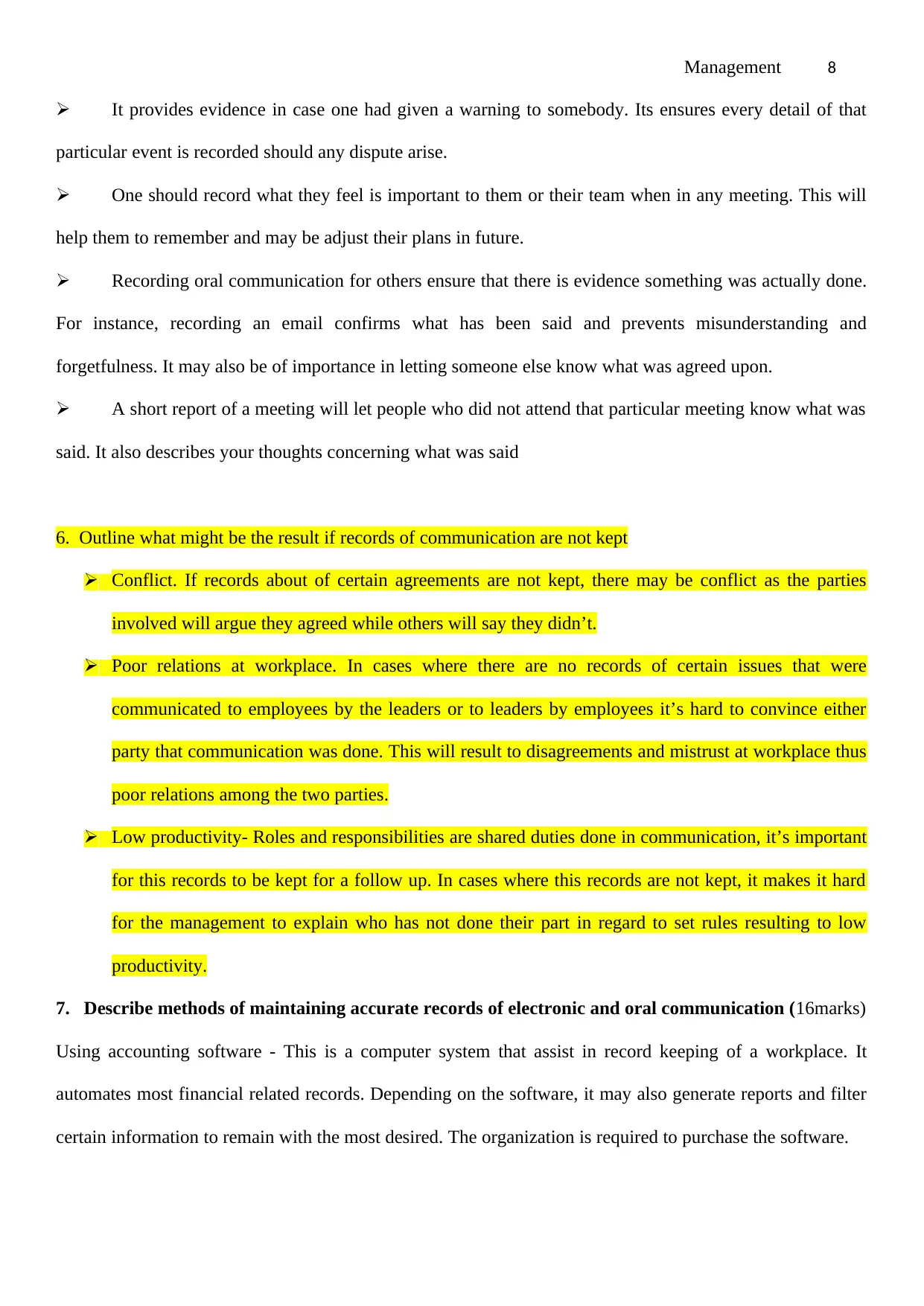
Management 8
It provides evidence in case one had given a warning to somebody. Its ensures every detail of that
particular event is recorded should any dispute arise.
One should record what they feel is important to them or their team when in any meeting. This will
help them to remember and may be adjust their plans in future.
Recording oral communication for others ensure that there is evidence something was actually done.
For instance, recording an email confirms what has been said and prevents misunderstanding and
forgetfulness. It may also be of importance in letting someone else know what was agreed upon.
A short report of a meeting will let people who did not attend that particular meeting know what was
said. It also describes your thoughts concerning what was said
6. Outline what might be the result if records of communication are not kept
Conflict. If records about of certain agreements are not kept, there may be conflict as the parties
involved will argue they agreed while others will say they didn’t.
Poor relations at workplace. In cases where there are no records of certain issues that were
communicated to employees by the leaders or to leaders by employees it’s hard to convince either
party that communication was done. This will result to disagreements and mistrust at workplace thus
poor relations among the two parties.
Low productivity- Roles and responsibilities are shared duties done in communication, it’s important
for this records to be kept for a follow up. In cases where this records are not kept, it makes it hard
for the management to explain who has not done their part in regard to set rules resulting to low
productivity.
7. Describe methods of maintaining accurate records of electronic and oral communication (16marks)
Using accounting software - This is a computer system that assist in record keeping of a workplace. It
automates most financial related records. Depending on the software, it may also generate reports and filter
certain information to remain with the most desired. The organization is required to purchase the software.
It provides evidence in case one had given a warning to somebody. Its ensures every detail of that
particular event is recorded should any dispute arise.
One should record what they feel is important to them or their team when in any meeting. This will
help them to remember and may be adjust their plans in future.
Recording oral communication for others ensure that there is evidence something was actually done.
For instance, recording an email confirms what has been said and prevents misunderstanding and
forgetfulness. It may also be of importance in letting someone else know what was agreed upon.
A short report of a meeting will let people who did not attend that particular meeting know what was
said. It also describes your thoughts concerning what was said
6. Outline what might be the result if records of communication are not kept
Conflict. If records about of certain agreements are not kept, there may be conflict as the parties
involved will argue they agreed while others will say they didn’t.
Poor relations at workplace. In cases where there are no records of certain issues that were
communicated to employees by the leaders or to leaders by employees it’s hard to convince either
party that communication was done. This will result to disagreements and mistrust at workplace thus
poor relations among the two parties.
Low productivity- Roles and responsibilities are shared duties done in communication, it’s important
for this records to be kept for a follow up. In cases where this records are not kept, it makes it hard
for the management to explain who has not done their part in regard to set rules resulting to low
productivity.
7. Describe methods of maintaining accurate records of electronic and oral communication (16marks)
Using accounting software - This is a computer system that assist in record keeping of a workplace. It
automates most financial related records. Depending on the software, it may also generate reports and filter
certain information to remain with the most desired. The organization is required to purchase the software.
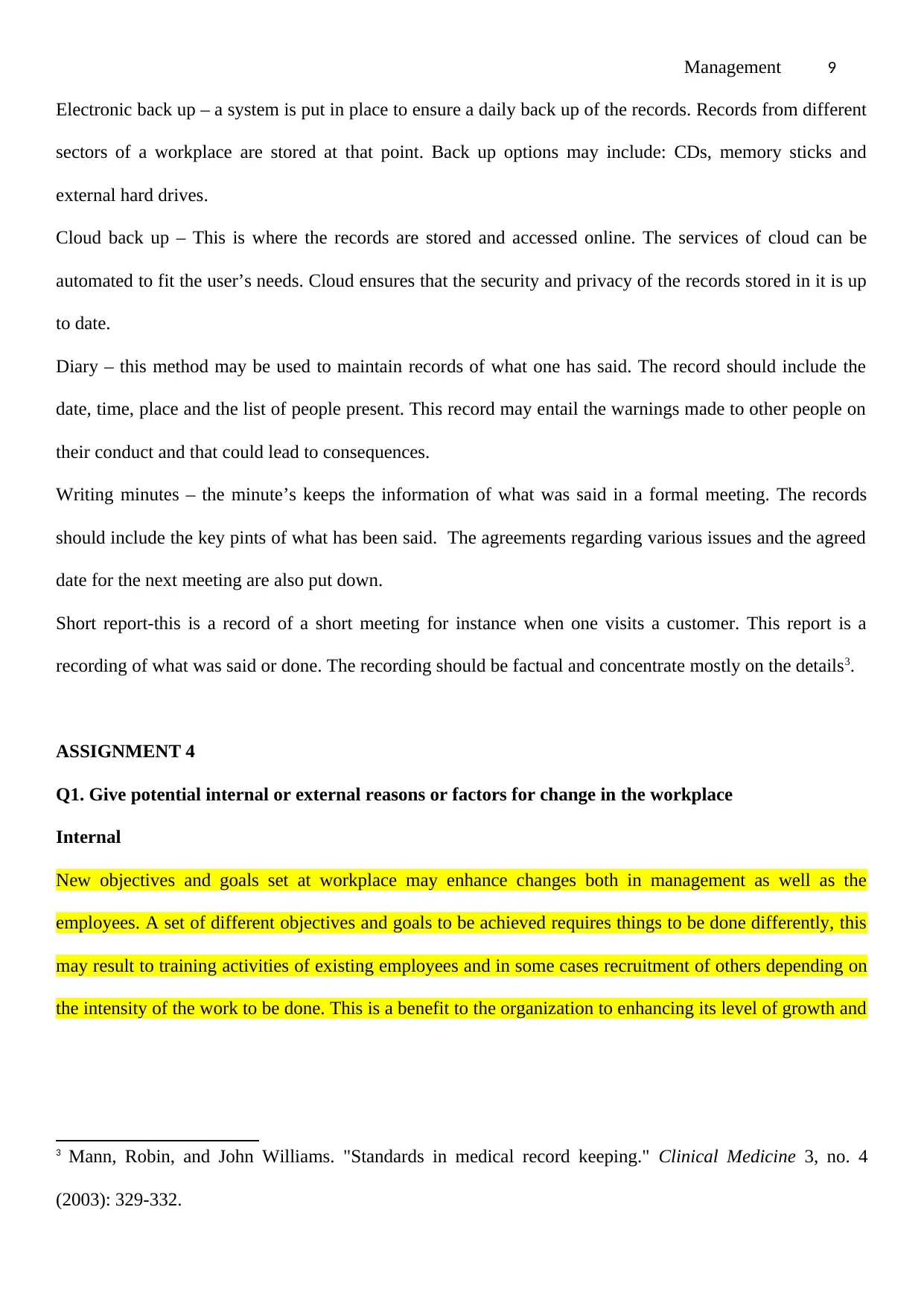
Management 9
Electronic back up – a system is put in place to ensure a daily back up of the records. Records from different
sectors of a workplace are stored at that point. Back up options may include: CDs, memory sticks and
external hard drives.
Cloud back up – This is where the records are stored and accessed online. The services of cloud can be
automated to fit the user’s needs. Cloud ensures that the security and privacy of the records stored in it is up
to date.
Diary – this method may be used to maintain records of what one has said. The record should include the
date, time, place and the list of people present. This record may entail the warnings made to other people on
their conduct and that could lead to consequences.
Writing minutes – the minute’s keeps the information of what was said in a formal meeting. The records
should include the key pints of what has been said. The agreements regarding various issues and the agreed
date for the next meeting are also put down.
Short report-this is a record of a short meeting for instance when one visits a customer. This report is a
recording of what was said or done. The recording should be factual and concentrate mostly on the details3.
ASSIGNMENT 4
Q1. Give potential internal or external reasons or factors for change in the workplace
Internal
New objectives and goals set at workplace may enhance changes both in management as well as the
employees. A set of different objectives and goals to be achieved requires things to be done differently, this
may result to training activities of existing employees and in some cases recruitment of others depending on
the intensity of the work to be done. This is a benefit to the organization to enhancing its level of growth and
3 Mann, Robin, and John Williams. "Standards in medical record keeping." Clinical Medicine 3, no. 4
(2003): 329-332.
Electronic back up – a system is put in place to ensure a daily back up of the records. Records from different
sectors of a workplace are stored at that point. Back up options may include: CDs, memory sticks and
external hard drives.
Cloud back up – This is where the records are stored and accessed online. The services of cloud can be
automated to fit the user’s needs. Cloud ensures that the security and privacy of the records stored in it is up
to date.
Diary – this method may be used to maintain records of what one has said. The record should include the
date, time, place and the list of people present. This record may entail the warnings made to other people on
their conduct and that could lead to consequences.
Writing minutes – the minute’s keeps the information of what was said in a formal meeting. The records
should include the key pints of what has been said. The agreements regarding various issues and the agreed
date for the next meeting are also put down.
Short report-this is a record of a short meeting for instance when one visits a customer. This report is a
recording of what was said or done. The recording should be factual and concentrate mostly on the details3.
ASSIGNMENT 4
Q1. Give potential internal or external reasons or factors for change in the workplace
Internal
New objectives and goals set at workplace may enhance changes both in management as well as the
employees. A set of different objectives and goals to be achieved requires things to be done differently, this
may result to training activities of existing employees and in some cases recruitment of others depending on
the intensity of the work to be done. This is a benefit to the organization to enhancing its level of growth and
3 Mann, Robin, and John Williams. "Standards in medical record keeping." Clinical Medicine 3, no. 4
(2003): 329-332.
⊘ This is a preview!⊘
Do you want full access?
Subscribe today to unlock all pages.

Trusted by 1+ million students worldwide
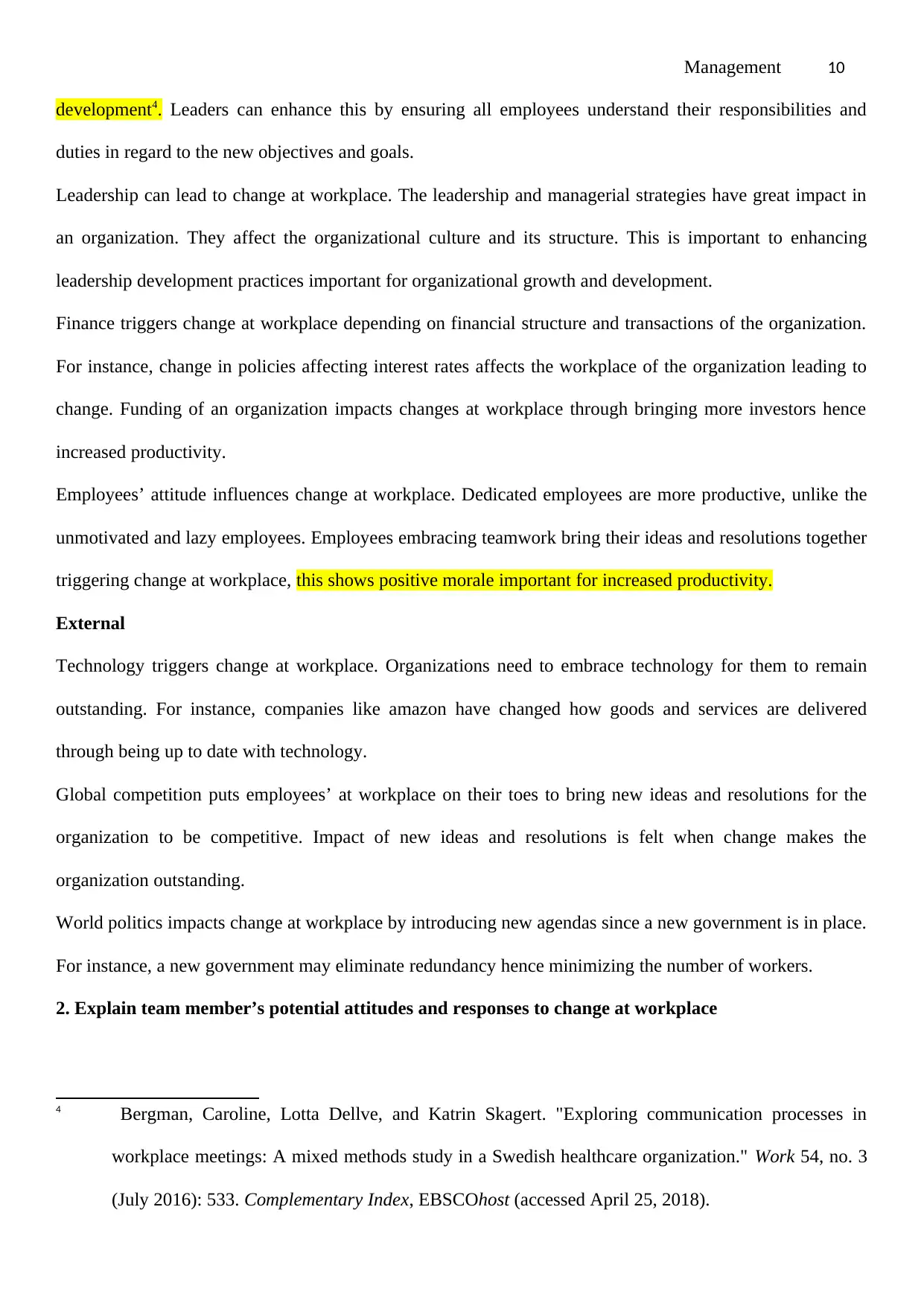
Management 10
development4. Leaders can enhance this by ensuring all employees understand their responsibilities and
duties in regard to the new objectives and goals.
Leadership can lead to change at workplace. The leadership and managerial strategies have great impact in
an organization. They affect the organizational culture and its structure. This is important to enhancing
leadership development practices important for organizational growth and development.
Finance triggers change at workplace depending on financial structure and transactions of the organization.
For instance, change in policies affecting interest rates affects the workplace of the organization leading to
change. Funding of an organization impacts changes at workplace through bringing more investors hence
increased productivity.
Employees’ attitude influences change at workplace. Dedicated employees are more productive, unlike the
unmotivated and lazy employees. Employees embracing teamwork bring their ideas and resolutions together
triggering change at workplace, this shows positive morale important for increased productivity.
External
Technology triggers change at workplace. Organizations need to embrace technology for them to remain
outstanding. For instance, companies like amazon have changed how goods and services are delivered
through being up to date with technology.
Global competition puts employees’ at workplace on their toes to bring new ideas and resolutions for the
organization to be competitive. Impact of new ideas and resolutions is felt when change makes the
organization outstanding.
World politics impacts change at workplace by introducing new agendas since a new government is in place.
For instance, a new government may eliminate redundancy hence minimizing the number of workers.
2. Explain team member’s potential attitudes and responses to change at workplace
4 Bergman, Caroline, Lotta Dellve, and Katrin Skagert. "Exploring communication processes in
workplace meetings: A mixed methods study in a Swedish healthcare organization." Work 54, no. 3
(July 2016): 533. Complementary Index, EBSCOhost (accessed April 25, 2018).
development4. Leaders can enhance this by ensuring all employees understand their responsibilities and
duties in regard to the new objectives and goals.
Leadership can lead to change at workplace. The leadership and managerial strategies have great impact in
an organization. They affect the organizational culture and its structure. This is important to enhancing
leadership development practices important for organizational growth and development.
Finance triggers change at workplace depending on financial structure and transactions of the organization.
For instance, change in policies affecting interest rates affects the workplace of the organization leading to
change. Funding of an organization impacts changes at workplace through bringing more investors hence
increased productivity.
Employees’ attitude influences change at workplace. Dedicated employees are more productive, unlike the
unmotivated and lazy employees. Employees embracing teamwork bring their ideas and resolutions together
triggering change at workplace, this shows positive morale important for increased productivity.
External
Technology triggers change at workplace. Organizations need to embrace technology for them to remain
outstanding. For instance, companies like amazon have changed how goods and services are delivered
through being up to date with technology.
Global competition puts employees’ at workplace on their toes to bring new ideas and resolutions for the
organization to be competitive. Impact of new ideas and resolutions is felt when change makes the
organization outstanding.
World politics impacts change at workplace by introducing new agendas since a new government is in place.
For instance, a new government may eliminate redundancy hence minimizing the number of workers.
2. Explain team member’s potential attitudes and responses to change at workplace
4 Bergman, Caroline, Lotta Dellve, and Katrin Skagert. "Exploring communication processes in
workplace meetings: A mixed methods study in a Swedish healthcare organization." Work 54, no. 3
(July 2016): 533. Complementary Index, EBSCOhost (accessed April 25, 2018).
Paraphrase This Document
Need a fresh take? Get an instant paraphrase of this document with our AI Paraphraser
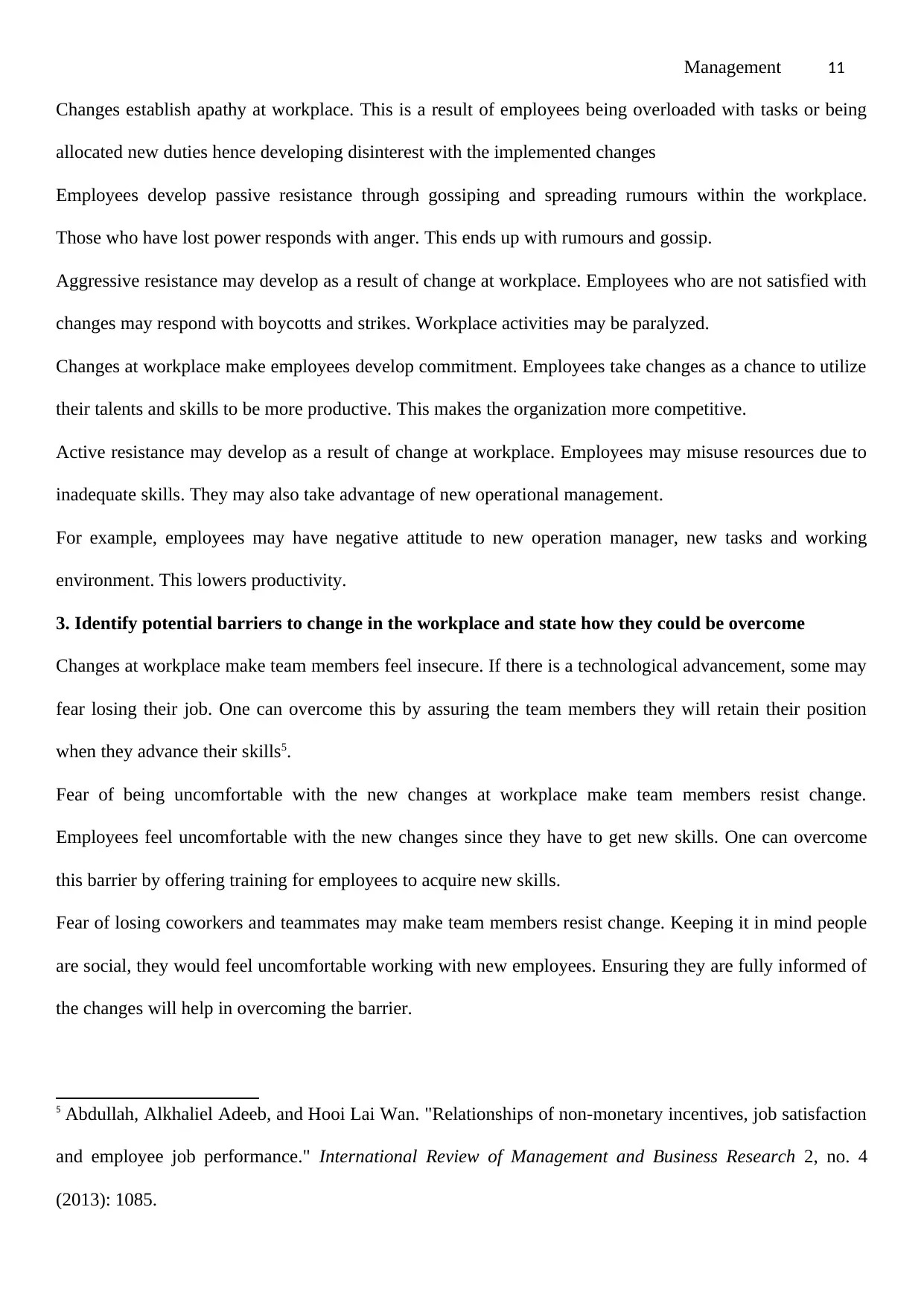
Management 11
Changes establish apathy at workplace. This is a result of employees being overloaded with tasks or being
allocated new duties hence developing disinterest with the implemented changes
Employees develop passive resistance through gossiping and spreading rumours within the workplace.
Those who have lost power responds with anger. This ends up with rumours and gossip.
Aggressive resistance may develop as a result of change at workplace. Employees who are not satisfied with
changes may respond with boycotts and strikes. Workplace activities may be paralyzed.
Changes at workplace make employees develop commitment. Employees take changes as a chance to utilize
their talents and skills to be more productive. This makes the organization more competitive.
Active resistance may develop as a result of change at workplace. Employees may misuse resources due to
inadequate skills. They may also take advantage of new operational management.
For example, employees may have negative attitude to new operation manager, new tasks and working
environment. This lowers productivity.
3. Identify potential barriers to change in the workplace and state how they could be overcome
Changes at workplace make team members feel insecure. If there is a technological advancement, some may
fear losing their job. One can overcome this by assuring the team members they will retain their position
when they advance their skills5.
Fear of being uncomfortable with the new changes at workplace make team members resist change.
Employees feel uncomfortable with the new changes since they have to get new skills. One can overcome
this barrier by offering training for employees to acquire new skills.
Fear of losing coworkers and teammates may make team members resist change. Keeping it in mind people
are social, they would feel uncomfortable working with new employees. Ensuring they are fully informed of
the changes will help in overcoming the barrier.
5 Abdullah, Alkhaliel Adeeb, and Hooi Lai Wan. "Relationships of non-monetary incentives, job satisfaction
and employee job performance." International Review of Management and Business Research 2, no. 4
(2013): 1085.
Changes establish apathy at workplace. This is a result of employees being overloaded with tasks or being
allocated new duties hence developing disinterest with the implemented changes
Employees develop passive resistance through gossiping and spreading rumours within the workplace.
Those who have lost power responds with anger. This ends up with rumours and gossip.
Aggressive resistance may develop as a result of change at workplace. Employees who are not satisfied with
changes may respond with boycotts and strikes. Workplace activities may be paralyzed.
Changes at workplace make employees develop commitment. Employees take changes as a chance to utilize
their talents and skills to be more productive. This makes the organization more competitive.
Active resistance may develop as a result of change at workplace. Employees may misuse resources due to
inadequate skills. They may also take advantage of new operational management.
For example, employees may have negative attitude to new operation manager, new tasks and working
environment. This lowers productivity.
3. Identify potential barriers to change in the workplace and state how they could be overcome
Changes at workplace make team members feel insecure. If there is a technological advancement, some may
fear losing their job. One can overcome this by assuring the team members they will retain their position
when they advance their skills5.
Fear of being uncomfortable with the new changes at workplace make team members resist change.
Employees feel uncomfortable with the new changes since they have to get new skills. One can overcome
this barrier by offering training for employees to acquire new skills.
Fear of losing coworkers and teammates may make team members resist change. Keeping it in mind people
are social, they would feel uncomfortable working with new employees. Ensuring they are fully informed of
the changes will help in overcoming the barrier.
5 Abdullah, Alkhaliel Adeeb, and Hooi Lai Wan. "Relationships of non-monetary incentives, job satisfaction
and employee job performance." International Review of Management and Business Research 2, no. 4
(2013): 1085.
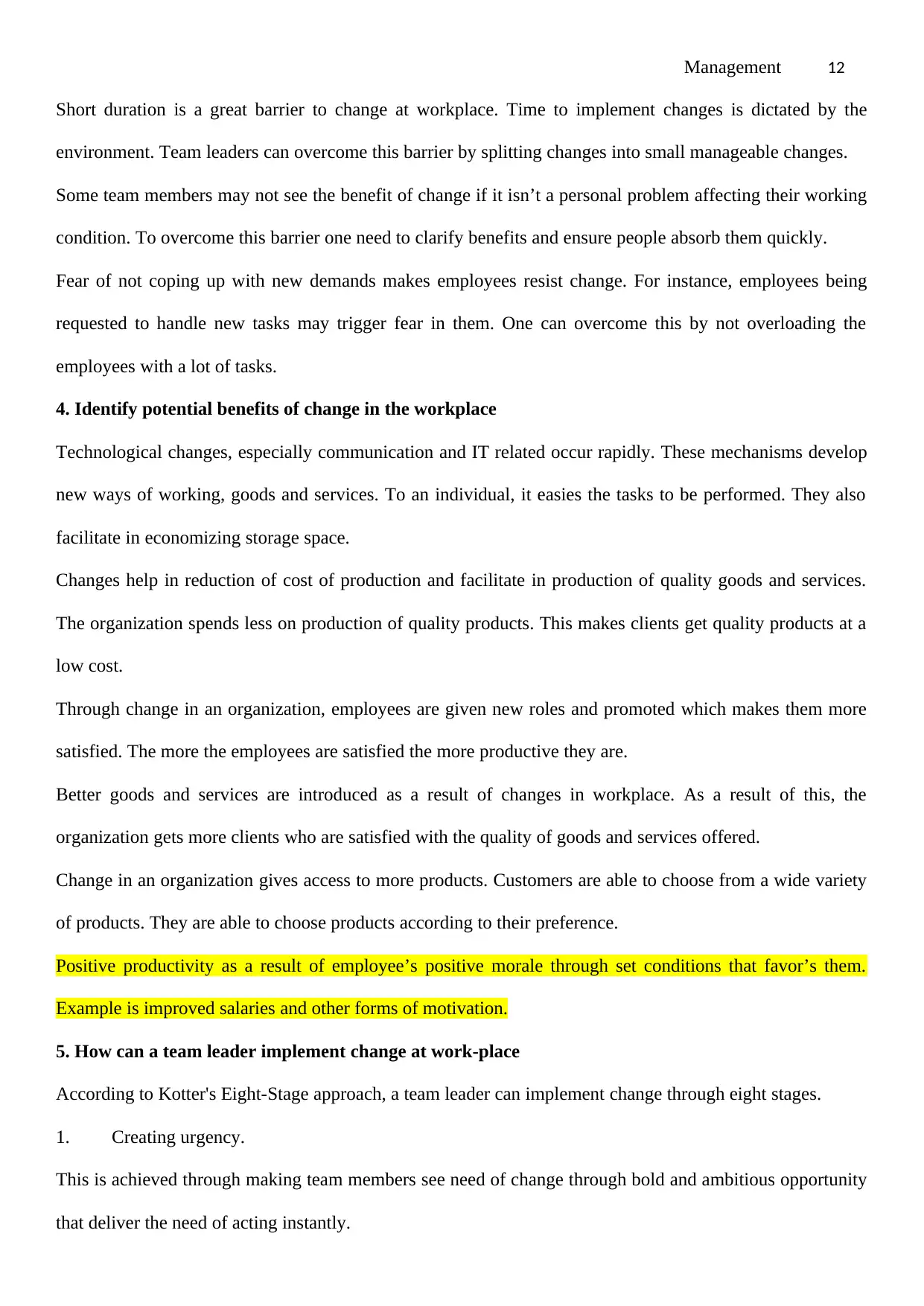
Management 12
Short duration is a great barrier to change at workplace. Time to implement changes is dictated by the
environment. Team leaders can overcome this barrier by splitting changes into small manageable changes.
Some team members may not see the benefit of change if it isn’t a personal problem affecting their working
condition. To overcome this barrier one need to clarify benefits and ensure people absorb them quickly.
Fear of not coping up with new demands makes employees resist change. For instance, employees being
requested to handle new tasks may trigger fear in them. One can overcome this by not overloading the
employees with a lot of tasks.
4. Identify potential benefits of change in the workplace
Technological changes, especially communication and IT related occur rapidly. These mechanisms develop
new ways of working, goods and services. To an individual, it easies the tasks to be performed. They also
facilitate in economizing storage space.
Changes help in reduction of cost of production and facilitate in production of quality goods and services.
The organization spends less on production of quality products. This makes clients get quality products at a
low cost.
Through change in an organization, employees are given new roles and promoted which makes them more
satisfied. The more the employees are satisfied the more productive they are.
Better goods and services are introduced as a result of changes in workplace. As a result of this, the
organization gets more clients who are satisfied with the quality of goods and services offered.
Change in an organization gives access to more products. Customers are able to choose from a wide variety
of products. They are able to choose products according to their preference.
Positive productivity as a result of employee’s positive morale through set conditions that favor’s them.
Example is improved salaries and other forms of motivation.
5. How can a team leader implement change at work-place
According to Kotter's Eight-Stage approach, a team leader can implement change through eight stages.
1. Creating urgency.
This is achieved through making team members see need of change through bold and ambitious opportunity
that deliver the need of acting instantly.
Short duration is a great barrier to change at workplace. Time to implement changes is dictated by the
environment. Team leaders can overcome this barrier by splitting changes into small manageable changes.
Some team members may not see the benefit of change if it isn’t a personal problem affecting their working
condition. To overcome this barrier one need to clarify benefits and ensure people absorb them quickly.
Fear of not coping up with new demands makes employees resist change. For instance, employees being
requested to handle new tasks may trigger fear in them. One can overcome this by not overloading the
employees with a lot of tasks.
4. Identify potential benefits of change in the workplace
Technological changes, especially communication and IT related occur rapidly. These mechanisms develop
new ways of working, goods and services. To an individual, it easies the tasks to be performed. They also
facilitate in economizing storage space.
Changes help in reduction of cost of production and facilitate in production of quality goods and services.
The organization spends less on production of quality products. This makes clients get quality products at a
low cost.
Through change in an organization, employees are given new roles and promoted which makes them more
satisfied. The more the employees are satisfied the more productive they are.
Better goods and services are introduced as a result of changes in workplace. As a result of this, the
organization gets more clients who are satisfied with the quality of goods and services offered.
Change in an organization gives access to more products. Customers are able to choose from a wide variety
of products. They are able to choose products according to their preference.
Positive productivity as a result of employee’s positive morale through set conditions that favor’s them.
Example is improved salaries and other forms of motivation.
5. How can a team leader implement change at work-place
According to Kotter's Eight-Stage approach, a team leader can implement change through eight stages.
1. Creating urgency.
This is achieved through making team members see need of change through bold and ambitious opportunity
that deliver the need of acting instantly.
⊘ This is a preview!⊘
Do you want full access?
Subscribe today to unlock all pages.

Trusted by 1+ million students worldwide
1 out of 17
Related Documents
Your All-in-One AI-Powered Toolkit for Academic Success.
+13062052269
info@desklib.com
Available 24*7 on WhatsApp / Email
![[object Object]](/_next/static/media/star-bottom.7253800d.svg)
Unlock your academic potential
Copyright © 2020–2025 A2Z Services. All Rights Reserved. Developed and managed by ZUCOL.




